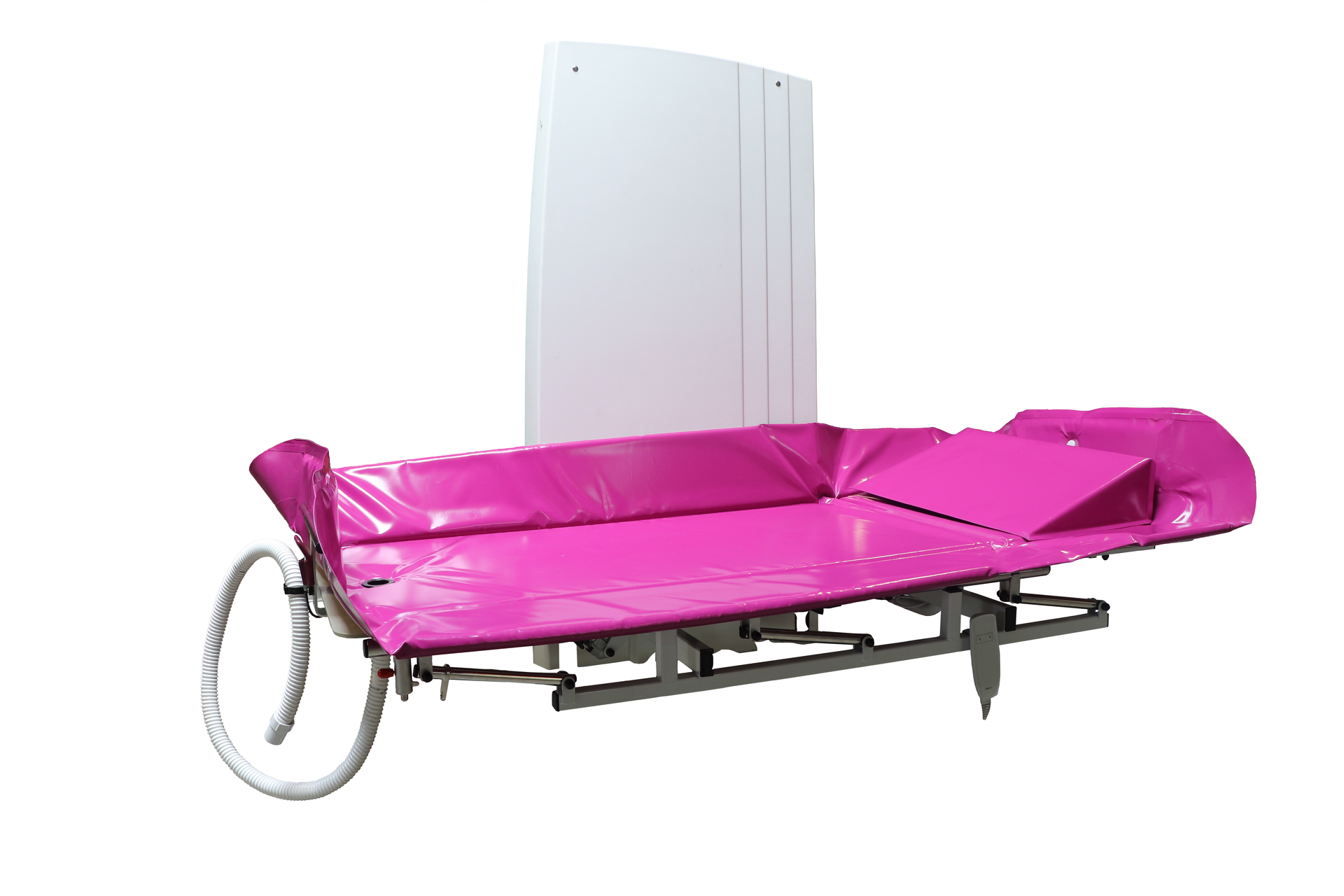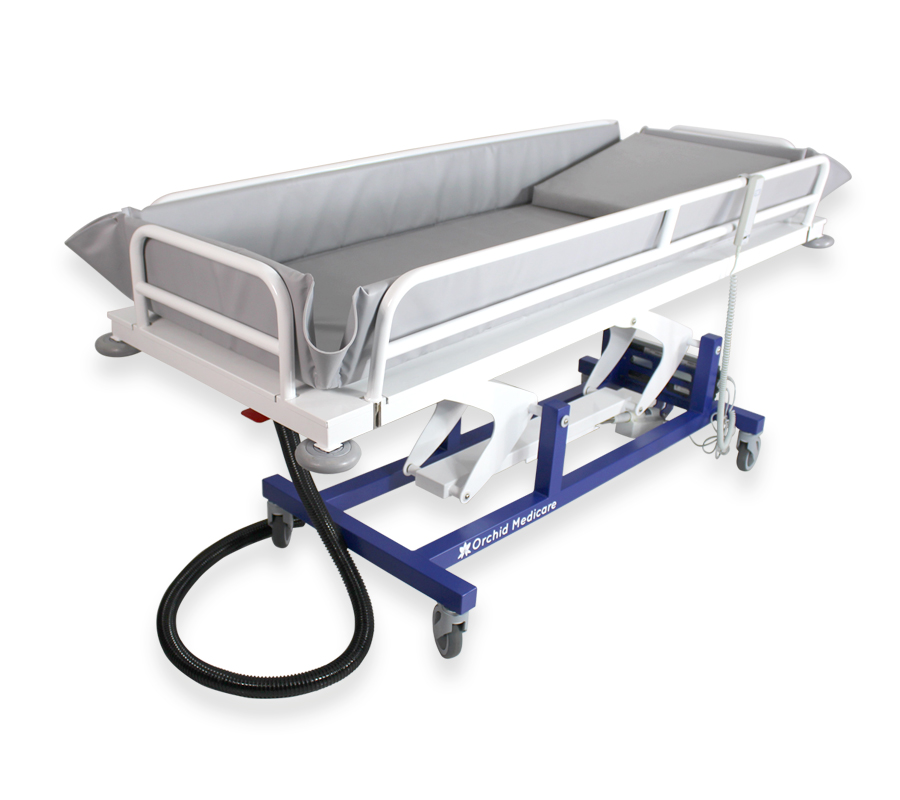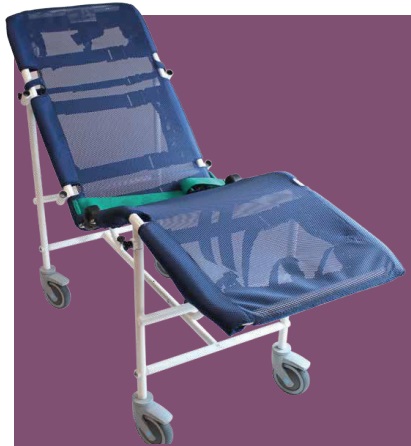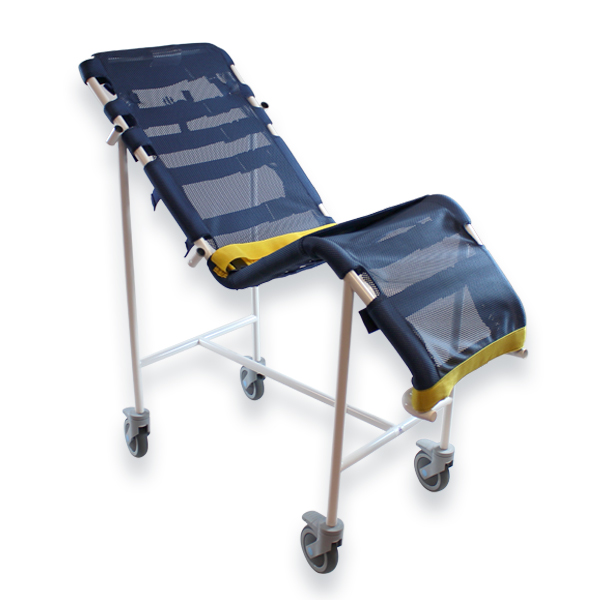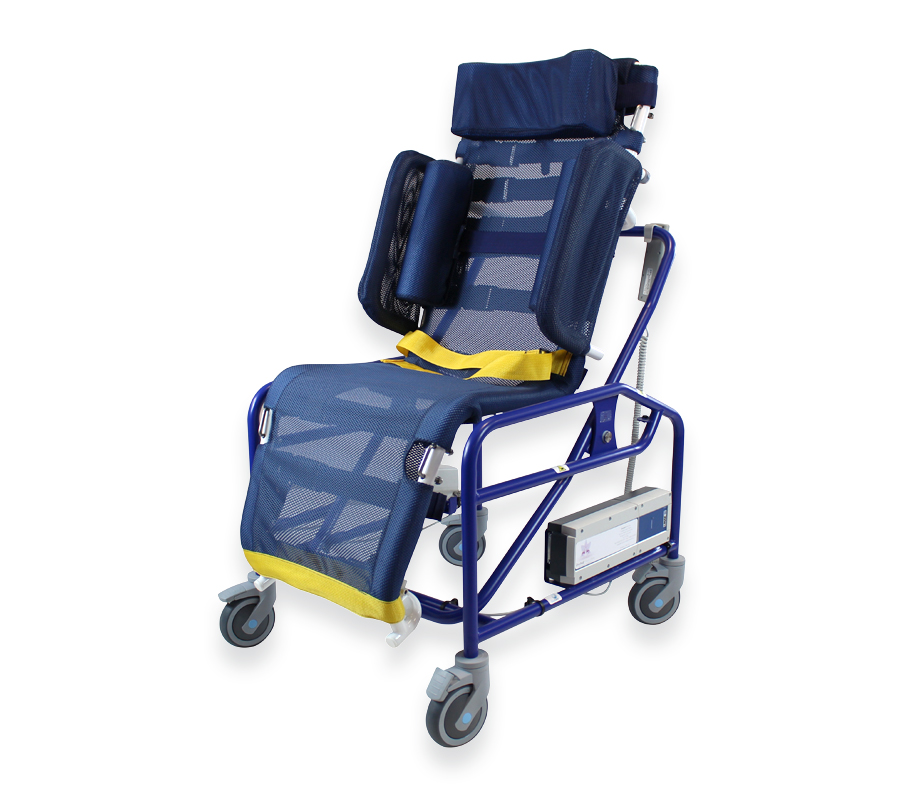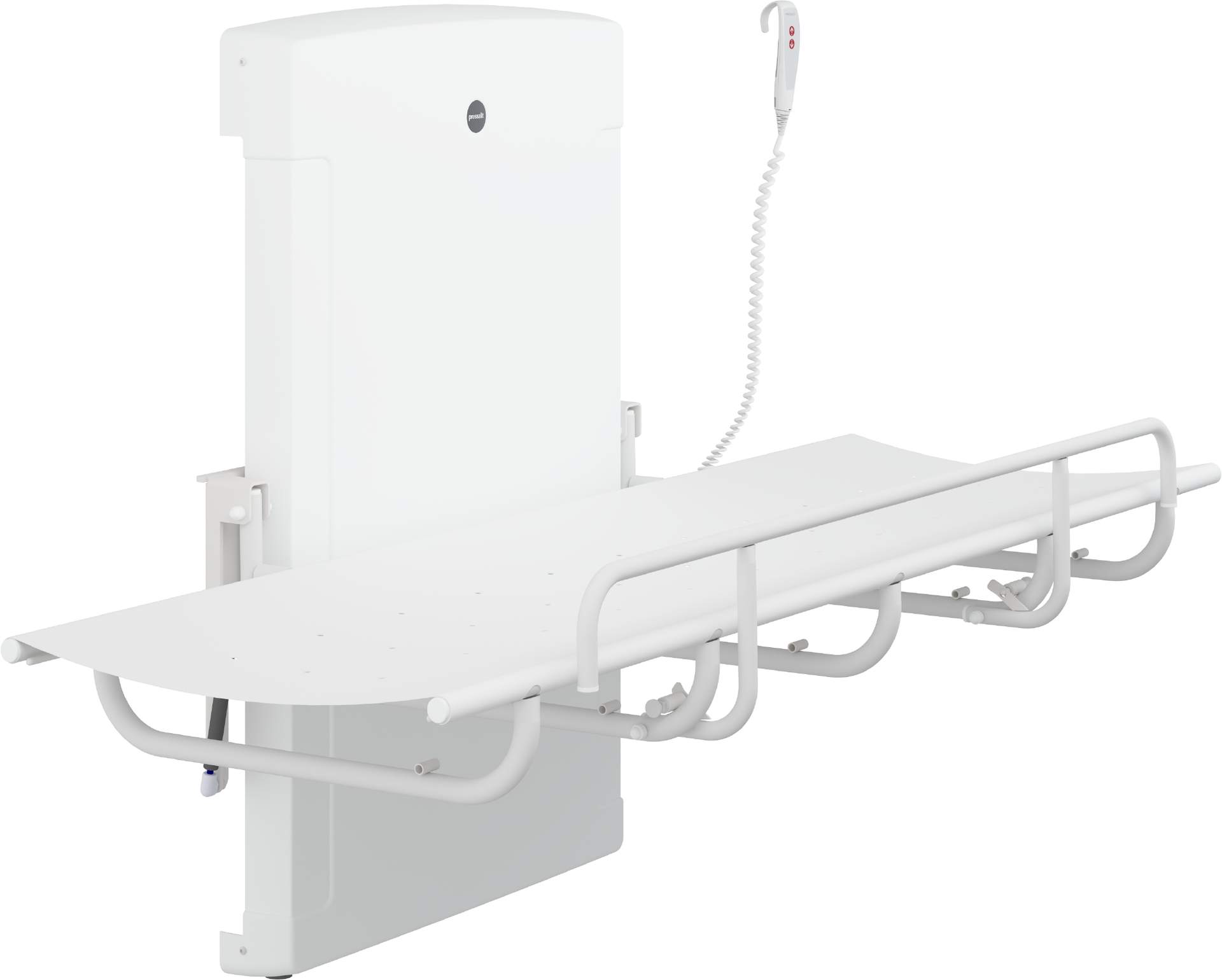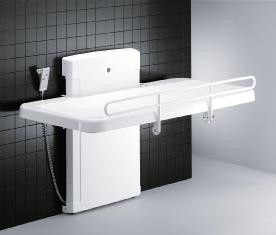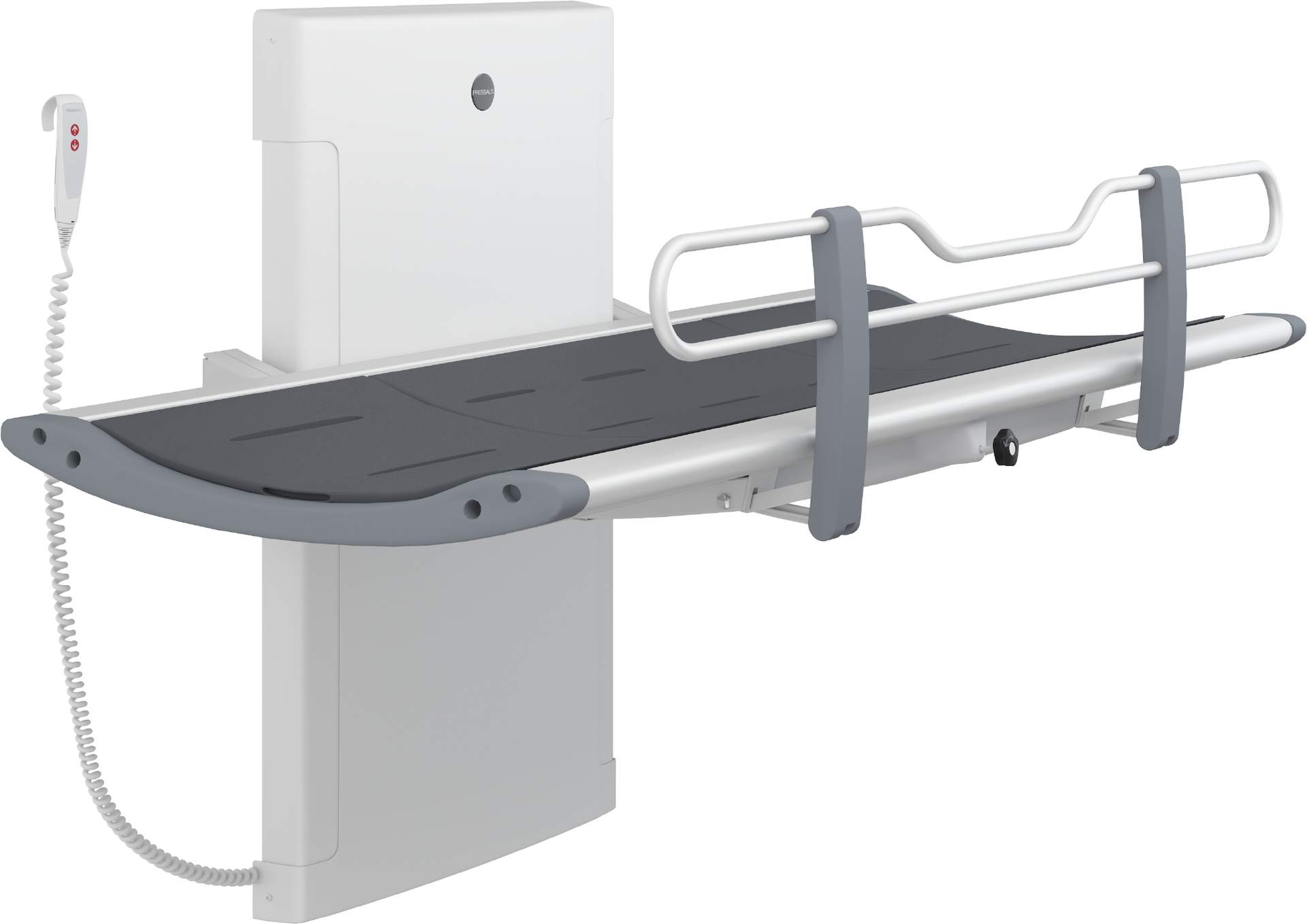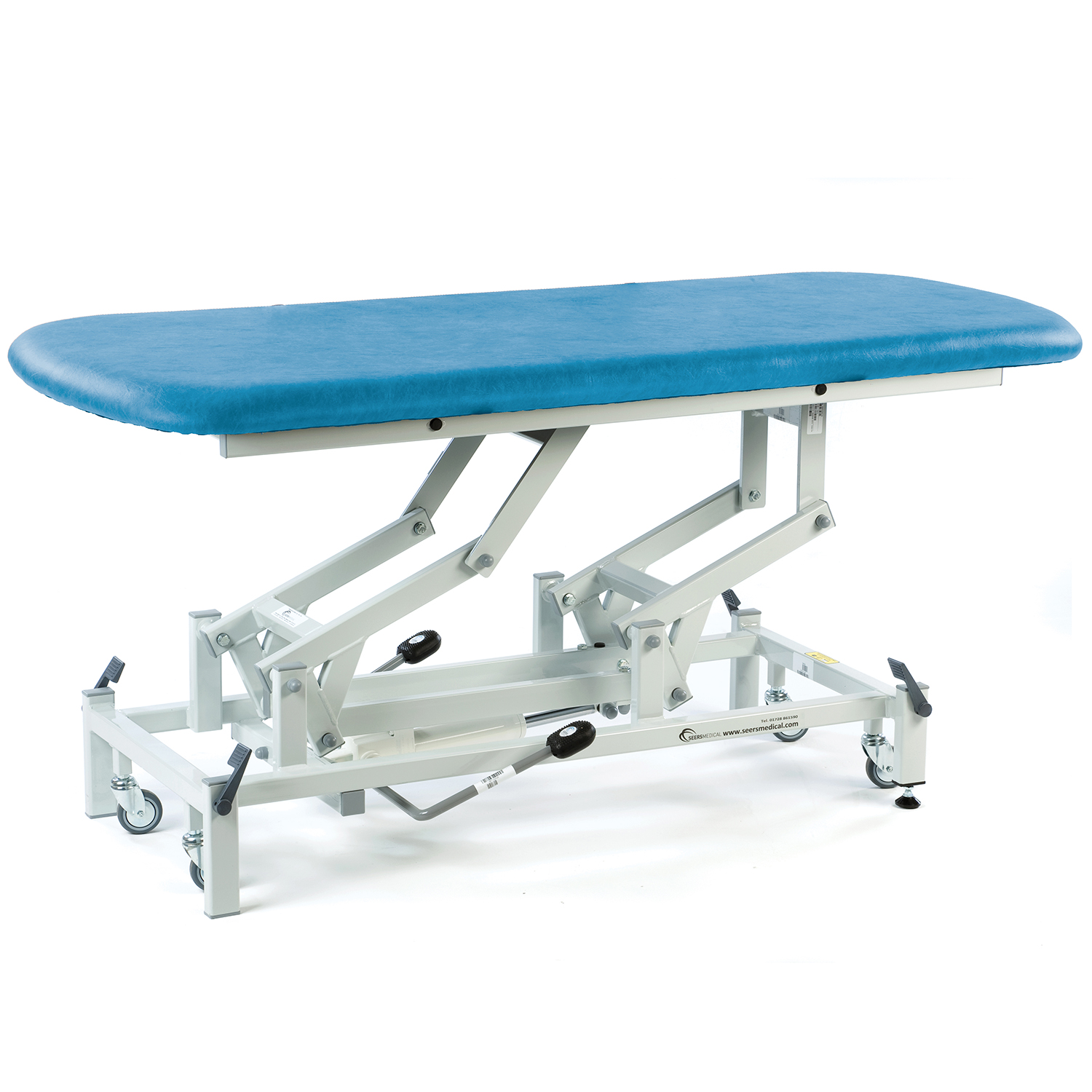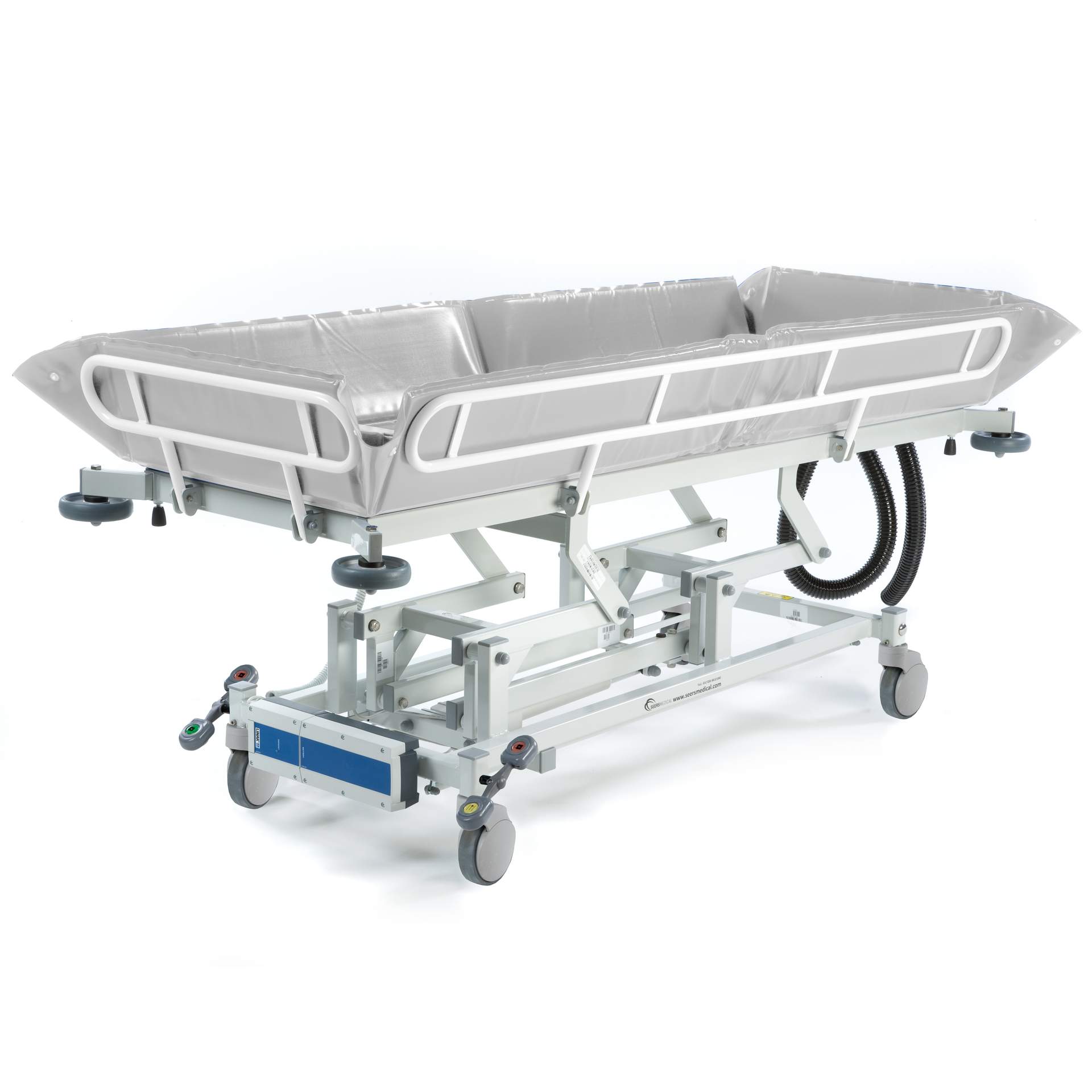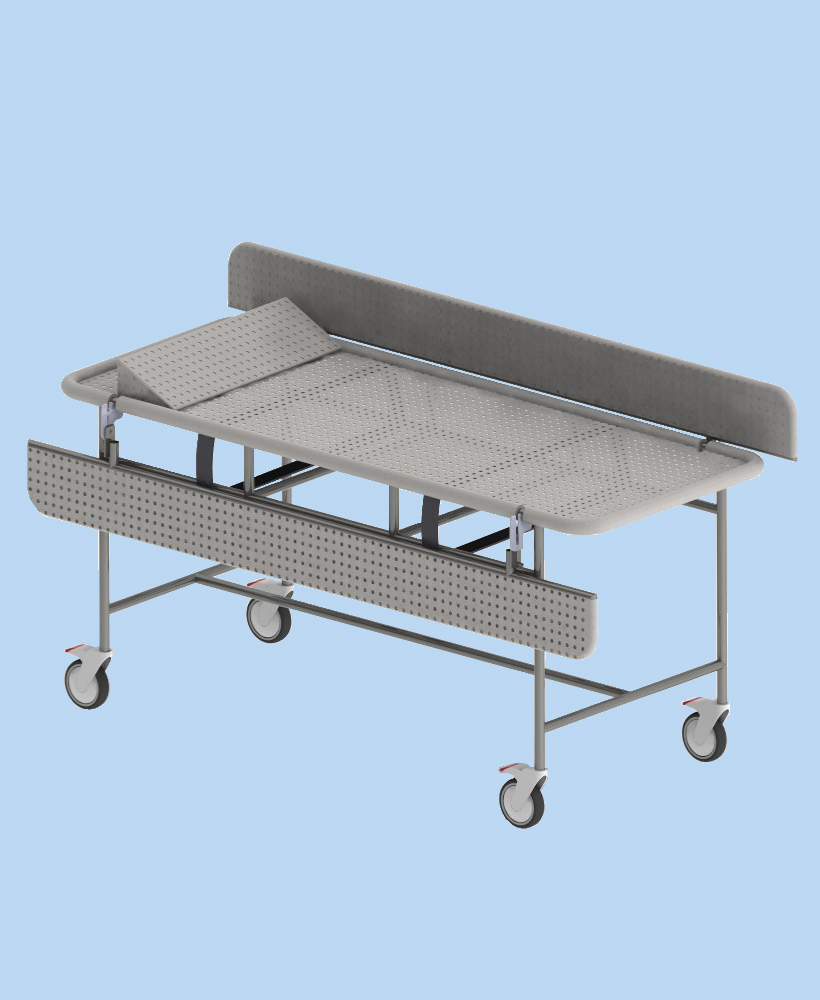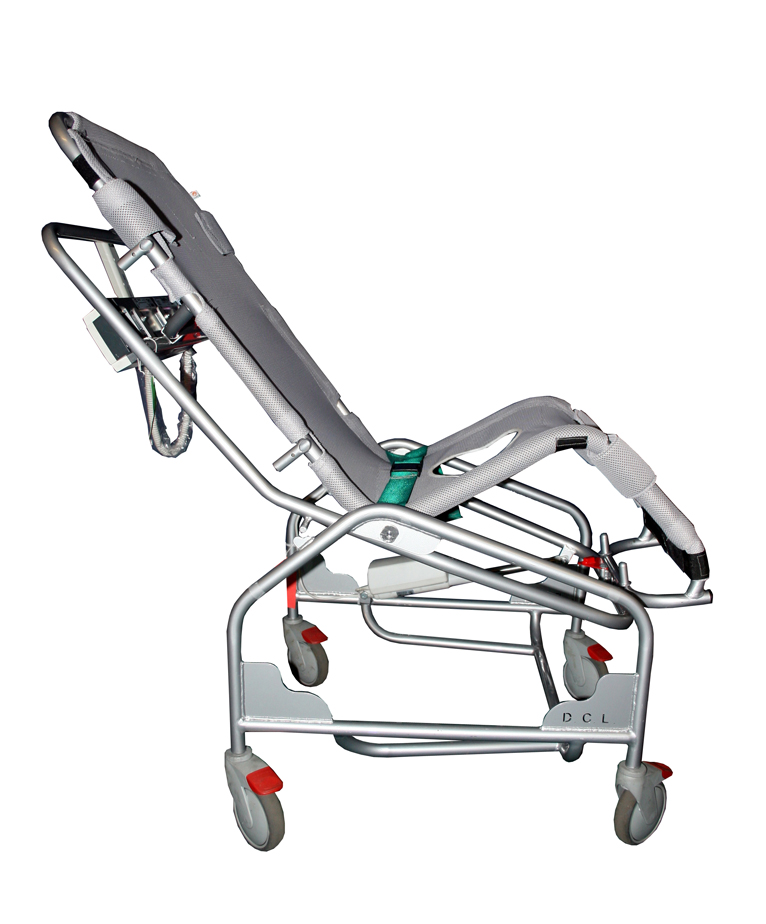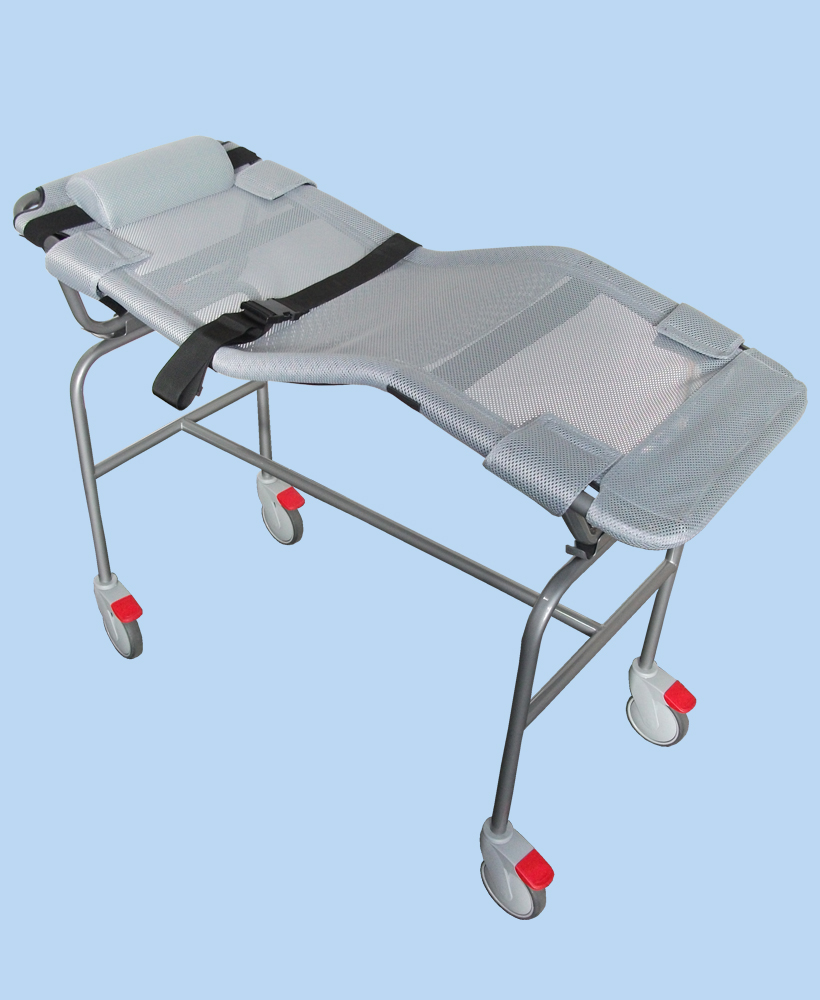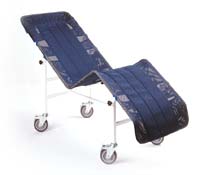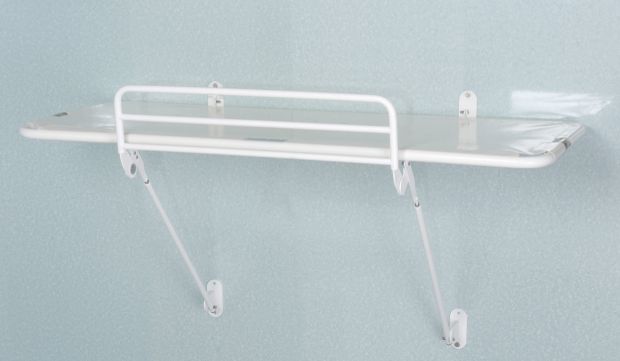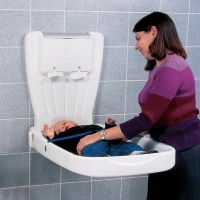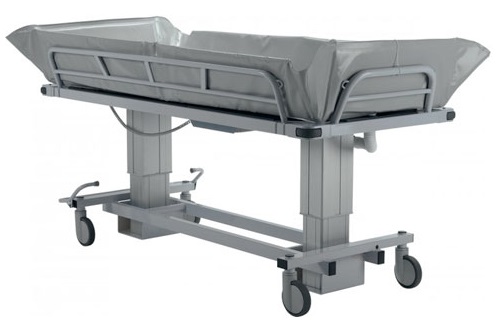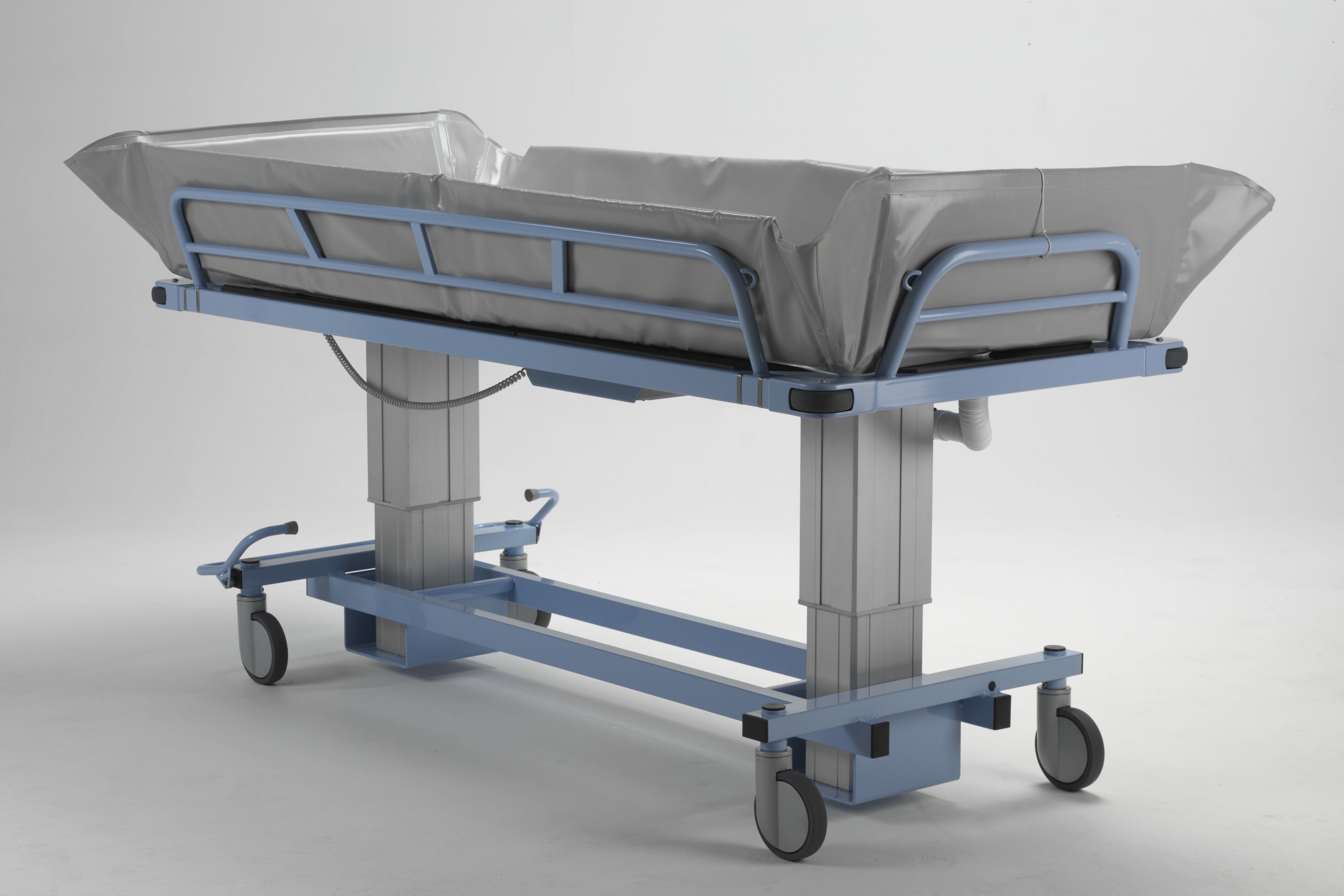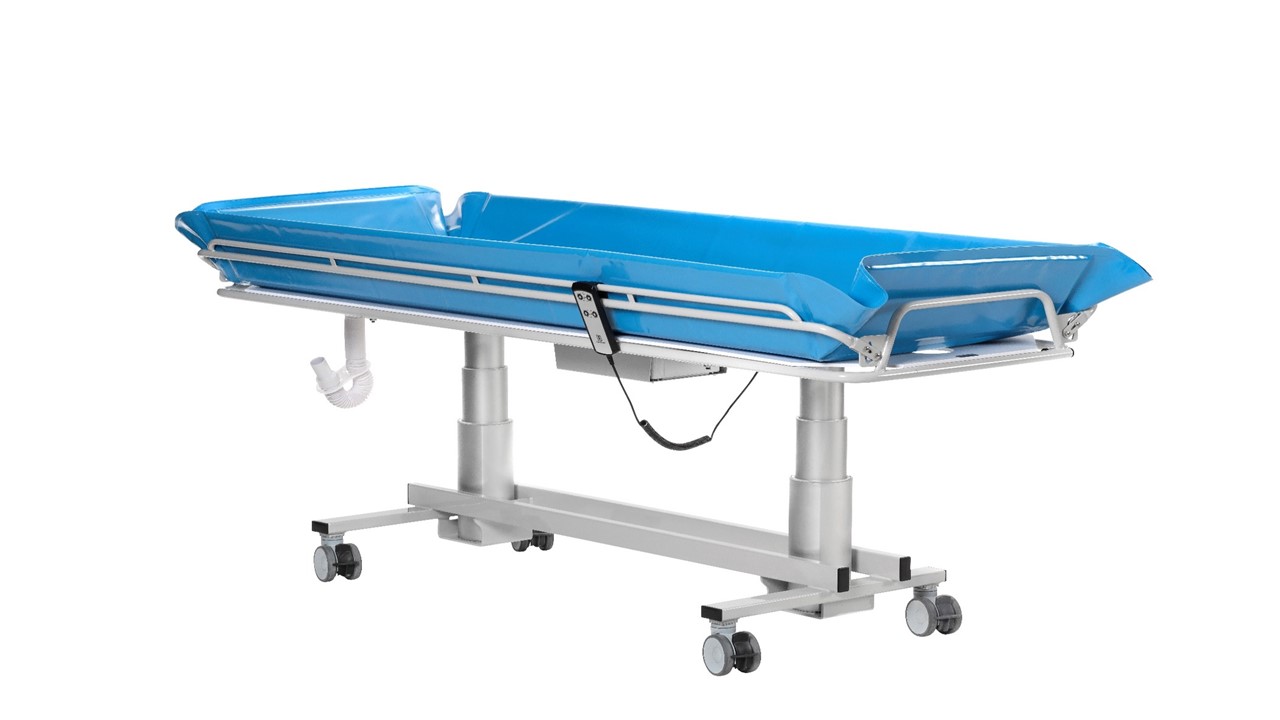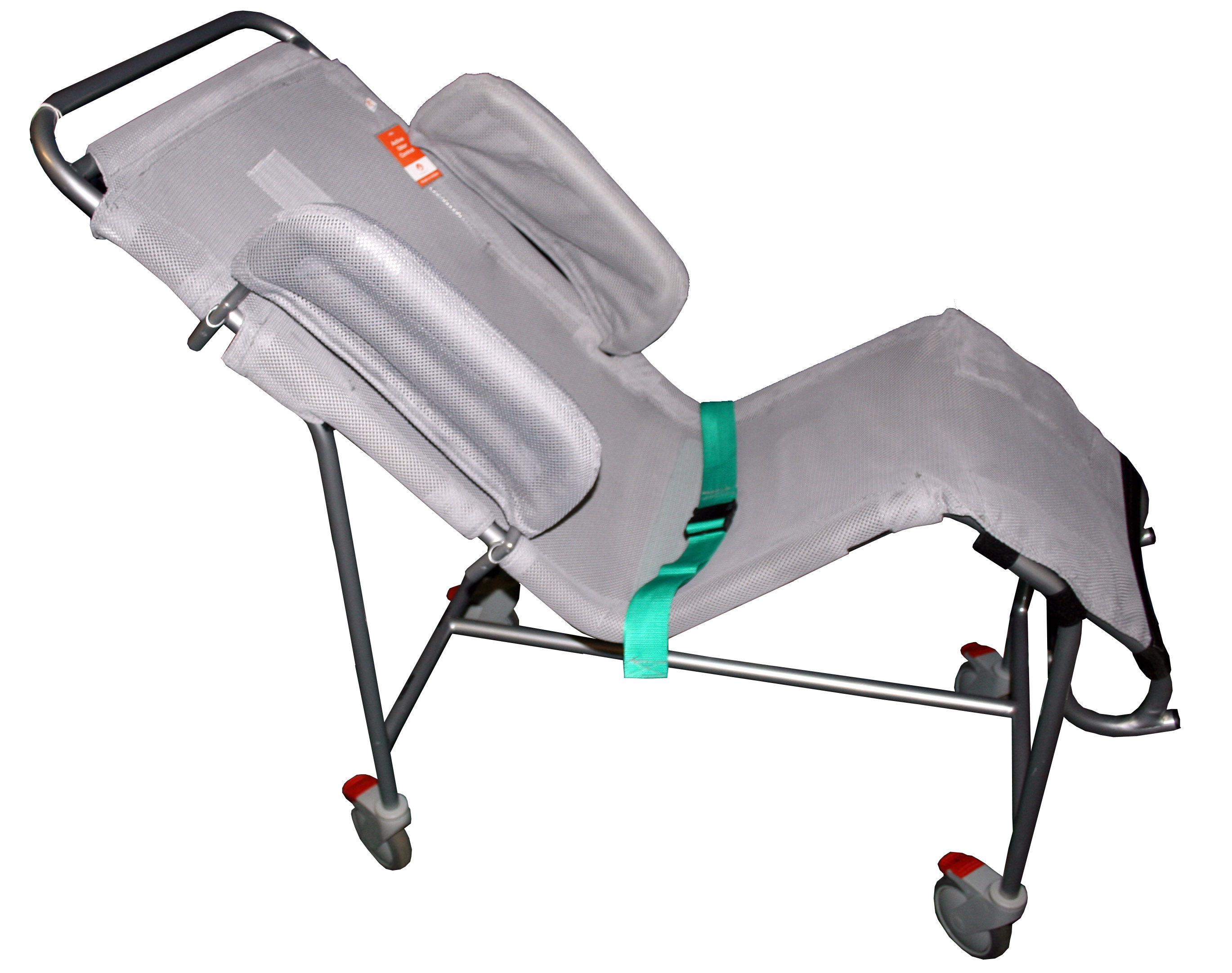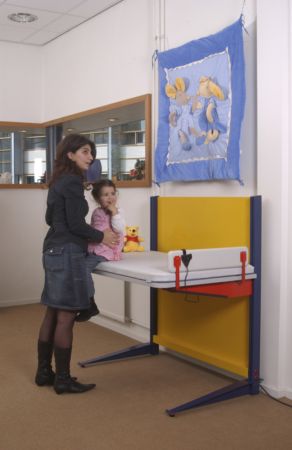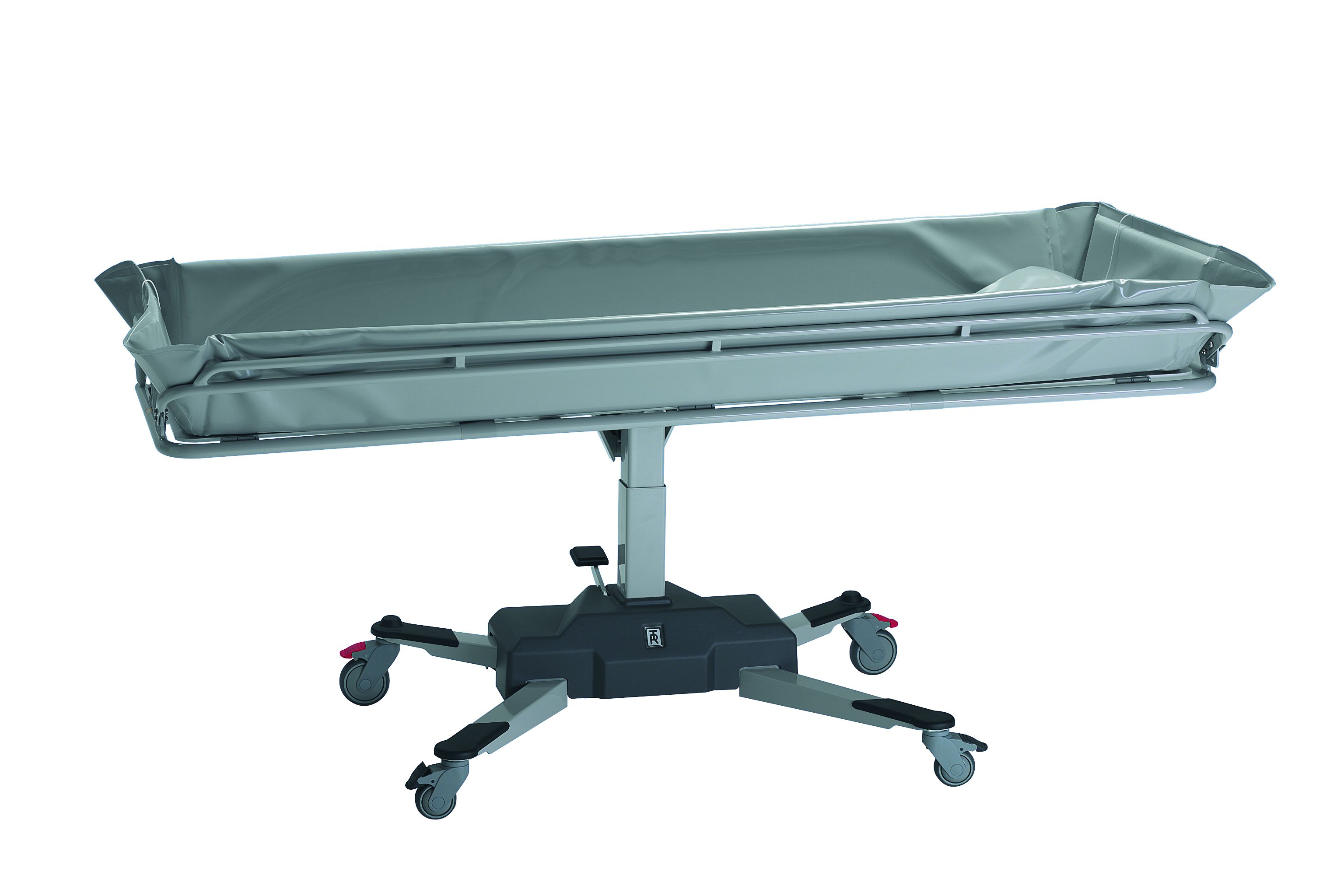Shower and changing tables
This section includes shower cradles, trolleys, stretchers and changing tables to assist with bathing and personal care. Some are designed to accommodate the size and weight of a heavier user. They are suitable for adults, children or both.
Shower cradles can be used with a mobile or ceiling track hoist to transfer a person into the bath. They are often customised to the posturing needs of the individual. They provide comfort, support and safety for individuals who may prefer bathing to showering. They can be combined with a multi-functional mobile chassis for use over a toilet, in a shower or as a transporter within the home. Some are mobile as standard.
Hinged shower stretchers and benches are for use in the shower or over a bath. Some can also be used as a changing table in a wet or dry area. They can be folded up against the wall when not in use.
Changing tables are free-standing or mobile and provide a surface on which a person can be changed, cleaned or dressed. Some are fixed height, others have height adjustment that may be operated electrically, mechanically or hydraulically so that the table can be positioned at a comfortable height for the carer. Many have safety guards and are usually used with hoist systems. Some have an adjustable angle backrest.
Introduction
This factsheet will provide basic information on a range of showering equipment that is available to you if you struggle with this area of self-care, with some suggestions for what you might need to consider as you look at your options.
Options for shower installation
Showers are either over-bath showers used within a bath tub, contained separately within a shower cubicle, or an open shower area/wetroom. There may be pros and cons about the different options and your individual circumstances may determine which will be the best option for you. Deciding factors may include:
- the facilities and the amount of space available
- your physical abilities and the amount of support you require
- your size and weight
- the cost and disruption involved for any installation.
Over-bath showers
Over-bath showers can be a cost-effective way of making use of a bath tub which may already be in place and which is used by other members of the household. It involves having a shower unit either attached to the water intake to the bath, or with its own plumbed water supply. Installation will involve some plumbing works. The shower controls will usually be fitted on the wall above the bath taps, at a height where you can comfortably reach them. If you are helped by a carer, you may want the control unit to be easily reached from outside of the bath.
In order to use this option you either need to be able to climb over the side of the bath and then remain safely standing whilst having a shower, or you need to use a board or seat set across the top of the bath to sit on whilst showering. You are advised to install grab rails for additional support and help with transferring in/out of the bath.
Shower cubicles
Access into a purpose-built shower cubicle is usually easier compared to getting into a bath tub, unless the step into the cubicle is too high. You are advised to install grab rails for additional support and help with transferring in/out of the cubicle.
There are essentially two kinds of shower cubicles:
- Corner cubicles - situated in a corner with the tiled bathroom walls forming two of the sides
- Full cubicles - can be situated anywhere as they have three solid sides and a cubicle door, thus enclosing the shower fully.
Although many cubicles are installed with sealed shower doors to minimise water spillage into the surrounding area, a pump will often be added to draw the water actively towards the drain. It is advisable to have some waterproof flooring immediately outside the area of the cubicle.
Cubicles can be bought with a range of shower seats, shower controls, shower outlets and rails according to your needs. Care should be taken over the choice of equipment used on plastic shower floor base trays, especially stools with three or four separate legs, because of the risk of puncturing the tray. Always make sure to check the maximum weight limit of the tray. Some companies will strengthen them for heavy users - check the manufacturer's guidance. Wall-mounted shower chairs may be an alternative.
Often entering a shower cubicle will require you to take a step upwards into it. Depending on your strength and balance it can be advisable to have a grab rail fitted to the wall to steady yourself when entering or using the shower. To eliminate this need a level access shower may be chosen which has the base almost flush with the floor. If you need to use a shower stool or chair, you must ensure that you still have adequate space to get into the cubicle and position yourself suitably. If you require the assistance of a carer, consider the space they may need to move, position and care for you.
Shower cubicles may have double or folding doors which open outwards or slide away, allowing for more space when entering or exiting. Low doors are available (750-900 mm in height) to allow for a carer to reach over them from outside the cubicle. A shower curtain is still necessary to prevent water splashing out onto the floor. Again, if you are helped by a carer, you may want the control unit to be easily reached from outside the shower cubicle.
Shower toilets
These are shower cubicles which have a toilet included within the unit. They may also be called showerloos.

You either sit on the toilet to shower or, as it has a ramped or level access, use an over-toilet shower chair. Some units also include a wash basin.
A shower toilet may be ideal if you do not have enough space for a separate toilet and shower. They may also be a solution if you can no longer access your bathroom and toilet, as it can be positioned in a room that suits you.
The toilet can function using a macerating unit so it can be sited virtually anywhere in your house and not just near your existing toilet's sump pipe.
Shower trays
Level or easy access trays

Level/easy access trays have an entrance threshold of less than 15mm. They are therefore easy to negotiate independently and put less stress on a helper's back if he/she is pushing you into the cubicle. However, there is more risk of water falling outside the tray with level access shower trays - try to ensure that the tray is sufficiently large to take account of the fact that the shower curtains may billow outwards slightly as the shower water hits them.
Some level access bases are designed to fit in the space where a bath stood, so that the drainage from the bath is already in place. Others require under floor drainage to be installed.
They often have a waste pump installed to draw the waste water away.
Ramped access trays
These trays are placed on top of the existing flooring and can be installed almost anywhere - even if it is not near to the main drains. The trays are raised at the front so that the water drains towards the back of the tray and is usually pumped above floor level to the main drains. A small ramp provides access for you to walk in, or be pushed in by a carer if you use a sanichair, a mobile shower chair or trolley.
However, consider the following:
- not all provide sufficient floor area to allow the use of a mobile chair, so always check the measurements carefully
- if a mobile chair is used, check that there is enough space around the cubicle to allow sufficient 'run up' and that the ramp is not too steep
- the mobile chair may have to be reversed into some small trays so that it can be conveniently positioned under the shower head.
Stepped access trays

These are the most common type of shower tray available from most standard plumbers’ merchants and DIY chains. However, they may not be suitable for many users’ needs due to the high threshold step.
They have a retaining 'barrier' at the lower front edge to stop the water from flowing out onto the floor - you need sufficient balance and mobility to step over this.
Although it is possible to transfer from a wheelchair onto an extended seat, a ramped or level access tray is usually much easier and safer.
A bath/shower step can also be used to split the height of the step into the cubicle into two steps.
Shower areas/wet rooms

In a shower area/wet room all or part of the bathroom is converted for showering. The shower area floor and walls are completely waterproofed. The floor may have an extended level access shower tray or is covered with suitable slip-resistant, waterproof flooring. The adjacent walls are sealed and usually tiled.
Shower areas/wet rooms offer a lot more space for showering, but need careful planning to ensure there are adequate safety and support features for those who need them.
Since there are no steps or ramps to negotiate, shower areas/wet rooms are easier if you require a mobile shower chair or cradle/trolley.
If you require assistance to shower there is more space, but your carer may get rather wet if there is no protection against the water. Waist height, wall-fixed or portable shower screens may be useful in this situation.
Waste pumps

Waste pumps can allow for a shower to be installed in parts of a home where gravity cannot be used to drain the shower, or where the floor is unbreachable or does not have enough space below it. The pumps actively pull water towards the drain outlet.
They are available with a range of maximum flow rates (how much water they pump from the shower in a set time period). Analogue drainage pumps will provide a constant rate of pumping and a fixed drainage speed, digital models vary the pumping rate depending on the volume of water flow from the shower.
Some pumps are activated by a flow switch installed in the water supply to the shower. When the shower is turned on water passes through the flow switch, activating the pump. Alternatively, the pump may be controlled directly by a connection to an electric shower, without the need for a flow switch.
Shower units
Thermostatic mixer showers

This type of shower uses pre-heated water from your home’s boiler or hot water tank, but has thermostatic controls which automatically compensate for any changes in water pressure. This ensures that if someone turns on the cold water tap elsewhere in the house, the person in the shower will not get scalded.
Some models will shut off completely if either the hot or cold water supply fails. Please see the section on Shower safety - temperature control below.
Instant or electric showers

Electric showers only have a cold water feed. They require a minimum water pressure in order to function properly, so almost always need a mains supply. You can use a tank supply as long as the tank is located over 8000-10,000mm above the electric shower unit.
They have an element (like an electric kettle) connected to the electricity supply which heats the water as it flows through the unit. The water temperature from an electric shower may fluctuate if the water flow to the shower is reduced, perhaps when someone else runs a tap. Temperature stabilised electric showers help to reduce the likelihood of these fluctuations, but if you require a guaranteed constant temperature you should consider a thermostatic electric shower.
Electric showers require particular wiring and fuse installations for safety and will require a trained electrician.
Please read about the BEAB CARE Mark under Shower safety - temperature control below.
Shower unit controls
Depending on your needs and preferences, it may be worth considering models which have pre-set controls or one control which regulates the rate of flow and temperature. The following types are available:
- lever controls
- dial control
- push button controls
- digital controls.
If you have sight loss you may wish to shortlist shower units that have achieved ‘RNIB approved’ endorsement. These showers are designed to make them safer for users with sight loss. They may feature a high visual contrast unit to stand out from the wall, a large on/off button and colour contrasting LED backlit buttons that emit audible beeps when they are pressed.
Digital shower controls allow you to programme your desired temperature etc. They incorporate thermostatic controls to prevent temperature variations. It is usual to have a second remote control unit so that the shower can be controlled from a distance. This can be useful for a carer.
Other features to look for include a shower head that can be easily adjusted on its riser rail, with a friction clamp bracket that can be operated with one hand. An extra long extended riser rail with an extra long hose will allow for seated or standing showering. If you are going to use a shower stool or chair, consider having the controls sited so they are easy to reach from a stable sitting position.
Getting in and out of a bath or shower
If you are beginning to struggle or feel unsafe when you get in/out of a bath or shower, it is time to consider installing some equipment to help you.
Shower boards, stools and chairs are made from non-corrodible materials so that it does not matter if they get wet. When considering shower seating, consider the seat height . If you can sit comfortably with your feet supported, you are less likely to slide forwards in the chair. Wall-fixed shower chairs can be fixed at the appropriate height, free-standing chairs and stools may have height adjustable legs. Many mobile chairs have adjustable height footrests to provide support.
If you require back support, a padded backrest will provide more support and be more comfortable than plastic moulded or tubular backrests.
Armrests provide support while you are seated, but should not be used to help you stay in the chair. If, without the arm supports, you would slide or fall, then you require a more supportive system. You are advised to seek advice from an occupational therapist.
Grab rails
The following specifications are recommended in Part M of the Building Regulations. However, they should be used only as a generic guide when the users are not known. When an individual user is known/for someone in their own home, personal factors such as the height of the person should be given priority:
Horizontal rails
Drop down or fixed rails attached either side of the shower seat can help to prevent somebody sliding off a wet slippery seat. A rail can be fixed on to the wall at the side of the shower seat, approximately 200mm above the height of any seat. This may be used for help when standing and may assist wheelchair users to transfer across onto the seat from a wheelchair. A drop down rail can be fixed on the rear wall, to drop down on the opposite side of the shower seat, with its top rail level with the wall-fixed rail.
In shower cubicles it may be useful to have an additional horizontal rail fixed on the wall opposite the shower seat at a height of 1m from the ground if it can be easily reached from the seat.
Vertical rails

A vertical rail at least 500mm long can be fixed at the entrance to the shower compartment for use when stepping in and out of the cubicle. The rail should be mounted at a height that the user can comfortably reach whilst stood both from outside the cubicle and from in the cubicle.
Vertical rails can be installed on a wall, if present, opposite a shower seat. The lowest fixing should be fixed 800mm above floor level. However, the distance between the front of the seat and the rail must be less than 550mm if it is to be used successfully. If it is too far away, there is a risk of falling forward.
Before installing a rail, you must ensure that the wall you fix it too is strong enough to support the rail and the weight placed on it
Shower boards

Shower boards fit across the width on top of the bath tub and secure with adjustable brackets against the inside of the bath. They need regular monitoring to ensure that they remain secure. They should not extend past the outer edge of the bath as this can cause them to tip up when sat on.
To transfer into the bath, you reverse towards the shower board and sit down on it before swinging your legs over the edge to place them on the floor of the bath. It is strongly advised to have wall fitted grab rails fitted to support yourself whilst completing the transfer. Whilst showering you would usually remain seated on the shower board, but some people prefer to stand up and hold on to grab rails for support. Shower boards are usually made from plastic, but can in some circumstances be made from coated metal or wood. They often consist of six or seven slats with gaps for the water to run through, but some have a perforated top surface. Some incorporate grab handles or indentations designed for you to hold on to.
Shower boards may sometimes also be called bath boards but we consider shower boards to have greater width/depth than bath boards, providing a greater area of support. Bath boards are narrower, to provide more room if you wish to transfer down onto a bathseat.
Shower boards and seats cannot be combined with a shower screen, but a shower curtain can be draped over the board/seat in order to contain the water. A bath board or swivel seat can only be used where there is adequate space to support the board/seat on both sides of the bath. You may want to consider a shower seat or stool which sits completely inside the bath.
Bath transfer benches
A transfer bench is a four legged seat which spans over the outer edge of the bath. They usually have a back rest and a single arm/handle on the end inside the bath. They are used in the same way as a shower/bath board, by reversing towards the bench, sitting down and swinging your legs over the edge to place them on the floor of the bath. Some people may find it easier to use than a board and it offers more support.
As the bench extends outside of the edge of the bath it is more difficult to keep the shower water in the bath, even using a shower curtain. A transfer bench does not require support on the bath rim on the far side of the bath, so may be useful when this is not available.
Swivel bath seats

Swivel bath seats fit over the bath and swivel to aid transfers over the bath.
These seats have a back support and armrests. Most have a lever to lock the swivel mechanism in place whilst you are sitting down on the seat and when over the bath.
These seats do not lower you into the bath - you shower from a seated position, or stand if you prefer.
Shower stools, seats and chairs
Please note: When you install a shower stool, seat or chair into a shower with a shower tray, or into a bath, you must ensure that the shower tray/bath is

designed to support the weight of a seated person, concentrated through the legs of the stool, seat or chair, otherwise the tray/bath may crack.
When you are looking at or researching seating options, the terms ‘stool’, ‘bench’ and ‘seat’ are often used interchangeably.
Shower stools
Shower stools are free standing stools with non-slip feet, and often have height adjustable legs. They sometimes have basic back support and may have tubular armrests or side handles. Some are foldable. They usually have a plastic seat and three or four legs, often made from aluminium or metal with non-corrosive coating. Hard wood designs are also available, but are not adjustable in any way.
Wall-mounted shower seats

A wall-mounted shower seat can either be static, or hinged, allowing it to be folded against the wall when not in use.
They often have two legs which rest on the base of the shower tray, but some sustain the weight of the user through the wall brackets only. The wall and fixings must be able to sustain the required weight of the user when resting on the seat.
Some have back support and armrests.
Shower chairs

Shower chairs are free-standing chairs which are either static or mobile. Static shower chairs have four, often height-adjustable legs, a seat and back rest, thus making them a sturdier option than the shower stools. Shower seats with armrests are also available. Some are foldable, some come with padded seating or a perforated plastic seat.
Similarly to shower stools, if you are considering using a shower chair it is strongly advisable you ensure the floor base you have can support this, as the weight can cause some shower trays to crack.
Mobile shower chairs have wheels and can either be self- or attendant-propelled. This enables you to push yourself, or be pushed, into a shower cubicle or area. They usually have a backrest, armrests and footrests. They take up more space than shower stools or hinged shower seats. Some mobile shower chairs have an over-toilet/commode facility and some have a tilt-in-space function.
Consider the following:
- the larger the wheels, the easier the chair is to push, whether independently or by your helper
- swivel front castors will make turning easier
- smooth surfaced floors are easier to push over than carpet
- make sure that there is enough space to manoeuvre the chair into position
- chairs with removable or foldaway armrests are usually easier to transfer on to than those with fixed armrests
- footrests that fold up and/or swing away can also make transfers easier and safer
- chairs with a folding frame can be useful for storing and transporting.
Shower chairs with castor bases

These small wheeled chairs have a metal frame and plastic seat. They are designed for you to be pushed into a shower area or cubicle. They may be difficult to push over some floor surfaces, e.g. thick carpet, since the small wheels offer more rolling resistance and are therefore more difficult to push. However, because of their smaller overall dimensions, they take up less space. There are generally brakes on all four castors.
Self-propelled wheeled shower chairs
With large rear wheels, these are designed for you to propel yourself independently into a shower area or cubicle. They may also be used as an attendant-propelled chair where the floor surface is difficult to push across, e.g. thick carpet, since large wheels offer less rolling resistance and are therefore easier to push. Check that you can operate the brakes.
Mobile shower, over toilet and commode chairs

Mobile combined shower, over toilet and commode chairs (sometimes called sanichairs) can be used in a shower but are also designed as mobile chairs with an aperture or hinged toilet seat for use over a toilet.
Some also have a tilt-in-space option. They are available with large or small wheels.
If you intend to use a multi-purpose chair, ensure that it is suitable for use in a shower.
Shower trolleys, cradles and benches
Shower cradles
Shower cradles are four-wheeled devices with a mesh fabric stretched over a metal frame. They have a small range of positions to choose from, enabling you to be showered in a semi-reclined position with knees and hips flexed. This helps to inhibit extensor spasm and provides a more stable position, but it will also reduce the overall length of the cradle so that it can be used in some shower cubicles. Using a cradle requires a carer to administer the shower. It also requires quite significant space to position the cradle.
The mesh is removable for washing and replaceable when needed. Side supports are available and belt straps to keep you safely in position when being showered. Some cradles have a folding facility for stowing away when not being used.
Users of shower cradles are usually hoisted into the cradle.
For more information about hoists, see our factsheet on selecting a hoist and slings for lifting a person.
Shower trolleys

Shower trolleys are effectively height adjustable platforms on a wheeled frame where you lie on a padded surface whilst being showered by one or two carers.
Shower trolleys have side supports and there is often a drain outlet in the foot-end to allow the water to run out, often through a hose to control the surrounding environment. They are designed for people with very high care needs and do require significant space in the shower area.
Due to their design, shower trolleys can make assisting with transfers easier for carers since sliding equipment can be used to transfer the user in a horizontal position directly from the bed onto the trolley, thus eliminating the need for hoisting.
Shower stretchers/benches
Hinged stretchers either fold down over a bath, resting on the bath rim, or are wall-mounted in a wet room area for use with a shower. Benches can also double-up as a changing facility.
The user will need to be hoisted onto the stretcher/bench by the carer. Wall mounted benches are either fixed height or height adjustable.
It is worth noting that although this equipment can make showering easier for the assistant (when the user is in a trolley or cradle, or is laid on a stretcher or bench) they have very little control and can feel very exposed and vulnerable. Consideration should be given to the user’s dignity and choice when considering this kind of equipment.
Equipment for use whilst showering
Shower head holders
If an existing shower installation is positioned where you can't reach the shower head, then shower head holders are available from many high street and DIY stores. They can usually be fixed to a wall with either screws or a suction cup attachment. Some shower head holders incorporate a built-in handrail.
Shower screens and enclosures

Shower screens and enclosures can be either wall fixed or portable and can be used in a range of walk-in showers or wet rooms.
They provide splash protection for carers and are usually 750mm or 900mm in height so the carer can reach over them.
They are available in a range of configurations.
Long handled bathing aids
There is a range of long handled washing and personal care equipment available.
These are designed to help make it easier to reach parts of your body when washing with less stretching or bending, for example washing your feet, back or between the toes.
It may be best to use this equipment whilst seated in your shower to help avoid any potential difficulty with your balance when reaching with the equipment
Leg lifters
If you have difficulty lifting your legs over the bath rim when attempting seated bath transfers on a shower board or swivel chair, a leg lifter may help.
Manual leg lifters consist of a reinforced strap with a loop on the end. You hook your foot through the loop and then, with your arms, physically lift the loop (and thereby your leg) up to the edge of the bath rim and then down into the bath.
Shower steps
Shower/bath steps can be used to provide a step-like platform outside a raised shower tray/cubicle, lessening the height which you need to lift your legs to get into the cubicle. However, they are not suitable for people who have difficulty keeping their balance, and they will not help you to lift your legs out from a deep shower tray.
If used, a slip-resistant step provides a safer surface to stand on and a grab rail mounted on the wall may provide a secure handhold to grip whilst using the step.
Anti-slip products
Self-adhesive strips or circles for use on the bottom of baths or shower trays are available and may help to reduce the risk of slipping in the bath or shower.
There are a wide range of bathmats readily available on the high street.
These mats are secured with sucker feet to the bottom of the bath, shower tray or cubicle, and are available in a range of sizes.
After showering
Body dryers
Body dryers use jets of warm air to dry you whilst standing.
They may be wall-mounted, mounted above you, or made to stand upon.
Wall-mounted body dryers can be positioned in the shower cubicle or on the wall in a shower area. It is not possible to dry all areas of the body from a seated position.
If space is available it may be possible to create an area adjacent to the shower area or have an extended cubicle which provides a dry area for dressing. This could be formed of a long bench seat which you can slide across.
Shower safety - temperature control
Certain groups of people are more vulnerable to scalding from hot water, including:
- children
- older people
- people with reduced mental capacity
- people with reduced mobility
- people with temperature sensitivity
- people who cannot react quickly enough to prevent injury.
If hot water used for showering or bathing is above 44 °C there is increased risk of serious injury or fatality, especially where large areas of the body are exposed to high temperatures.
The Department of Health (2016) recommends the temperature for bathing should be no higher than 44oC and showering at no higher than 41oC. For babies, the temperature should be no higher than 37oC.
Thermostatic mixing valves
A ‘point of use’ or ‘outlet’ thermostatic mixing valve (TMV) is a valve that blends hot water with cold water to ensure constant, safe shower and bath outlet temperatures, preventing scalding. They may be called thermostat taps.
They maintain the pre-set temperatures even if the water pressure varies when other appliances are used and provide a high level protection against scalding and thermal shock.
When looking at thermostatic mixing valves check for TMV2 certification. This means that the product meets national and international standards (BS EN 1111:2017 and BS EN 1287:2017) and is considered suitable for installation in domestic properties. Purchasing a TMV2 compliant valve is an assurance that a new bathroom will meet the requirements for safe shower use.
The BEAB Care Mark has been developed to demonstrate that water heater products comply with additional requirements to existing safety standards which take into account the needs of people in care situations, such as disabled and older people. It is a useful indicator when considering a shower system for anyone who has additional needs in their own homes.
A BEAB CARE Mark approved product will ensure stable outlet water temperatures under normal supply variations. In addition, the product will protect from scalding under rapid and abnormal supply variations, without adjustment by the user.
Water temperature indicators
Specific shower thermometers are available which fit onto all standard shower heads and shows a reading of the water temperature in order to prevent burns. Some have an acoustic and/or a visual alarm system.
Bath thermometers may give an idea of temperature of water from a shower, but are not designed for that purpose as they are generally designed to float or be submerged in the water.
Bath temperature indicators show when the temperature of the bath or wash hand basin is above a safe level by changing colour or giving a reading of the water temperature.
Some are preset within a safe range, which is usually 34-37oC for the bath and usually 42-47oC for the wash basin. When the temperature of the water goes higher than this, they may emit a warning such as a change of colour or sound an alarm.
Some can also sound an alarm to warn of a dangerous water level which could lead to flooding.
Accessing your needs
Showering may be chosen because it is a personal preference or because getting in and out of the bath has become too difficult or hazardous. If you need help for bathing, showering may offer the possibility of washing independently once again. Taking a shower can also reduce the risk of injuring a carer's back as it can avoid the need for them to help you transfer in and out of a low bath.
There are a number of factors about yourself to consider in order to know what equipment might help you. This may be defined by how able you are to:
- get into and out of the shower
- remain standing for a length of time
- maintain your balance
- avoid slipping, tripping or falling
- wash yourself, or have someone wash you
- dry yourself, or have someone dry you.
Consider your ability to grip onto a grab rail. Do you have reasonable hand strength? Do you ever have pain in your hands, wrists, elbows or shoulders which would prevent you from pulling up or pushing down on a grab rail? If your grip is good, if you are relatively steady on your feet and if you are able to manage stepping up and down into a shower, or over a bath side, the installation of grab rails in a standard shower may be adequate to meet your needs.
If you have poor grip, pain in your hands, arms or shoulders, or if you are very unstable when standing and you find it difficult to bear your own weight, simple grab rails may not be the most suitable answer for you. You are advised to look at options for remaining seated whilst showering.
If you cannot maintain standing and you find walking or moving your legs difficult, or you are at all unsteady, you are advised to consider a mobile chair, in which you can be pushed into the shower. You will consequently need to look at level access showers.
If you are a particularly large person, you are advised to weigh yourself accurately. You can then ensure that any equipment that you buy, or with which you are supplied, is suitable and safe for you.
If you are unsure about the best way to maintain your safety and independence, you are advised to seek a formal assessment of your needs from your local authority social services department, or from a private/independent occupational therapist.
Health and social care needs assessment
If you are struggling with caring for yourself, or your carer is struggling to provide care for you, consider asking for a health and social care needs assessment. Since the Care Act 2014came into power in April 2015, anyone who appears to need care and support can request an assessment from their local council, irrespective of their income or savings. The Act also places a statutory duty on local authorities and the NHS to support individuals to take steps to prevent their ill health or care requirements from getting worse. These strategies for prevention can include the early provision of equipment and services to help prevent, delay or reduce the development of further need for care and support, which may include showering equipment, depending on the cost.
The care and support assessment aims to identify any difficulties you may having in caring for yourself and how this impacts upon your wellbeing. If you have someone who helps you, they can have a carer’s assessment to see if they also need support to continue in their caring role.
Funding sources
Local authority funding for minor adaptations varies slightly across the UK. In England, if you are assessed as requiring preventative intervention, items like grab rails and basic showering equipment under £1000 would be free of charge to you. In Scotland, Local Authorities make their own arrangements for provision of minor adaptations and details can be accessed via your local authority website.
If the equipment or adaptation cost more that £1000, you may have to apply for a Disabled Facility Grant.
If you are considering major adaptations, such as building a downstairs bathroom for someone who cannot use the stairs, check that all other options have been considered. For example, it may be more practical and cheaper to install a stairlift or through-floor lift to provide easy access to the first floor.
Statutory direct payment, personal budgets and prescriptions
You may be provided with equipment and services as a preventative measure, before a full needs assessment is done. You would not pay for this. If, on assessment, your needs are high enough to qualify for further help from the council, they will then look at your income and savings to see whether you will need to pay towards any future services you receive. These services might include further disability equipment or adaptations to your home, help from a carer, telecare, the delivery of meals or residential care.
If you are provided with direct payments or a personal budget from the council, you can pay for equipment and other one-off purchases, so long as they have been identified as needed in your health and social care assessment.
In many areas a range of simple aids to daily living may be available on a prescription, issued by the assessor. If you receive a prescription for equipment you can take it to a local accredited retailer, which may be a local pharmacy, who will provide you with the item. You can pay extra for an alternative item, so long as it does what the specific item prescribed would do. Your choice may offer extra features, or perhaps you prefer its appearance.
If you are unsure about obtaining equipment, seek advice from your local authority. They should be able to provide you with information and advice about services or resources which could help you.
Private purchase
If you decide to buy equipment privately it is best to try and compare the different options first. You may have an equipment demonstration centre near you where you can view and try out different equipment. You will receive impartial advice to help choose appropriately.
Look for a sales company that belongs to a trade association, such as the British Healthcare Trades Association (BHTA). BHTA members have signed up to a code of practice governing standards of customer service.
Charity and grant funding
Charitable trusts may sometimes provide funding for equipment. Charities tend to give awards in accordance with a predetermined criteria, so it is important that you carefully select the organisations that you apply to.
Disabled Facilities Grants (DFGs)
A local authority Disabled Facilities Grant, often referred to as a DFG, may be available for essential home adaptations for you as a disabled person, if they are deemed ‘necessary to meet your needs’ and the work is ‘reasonable and practical’. This can include extensions and structural work to accommodate fixed hoists, stairlifts, downstairs bathrooms, shower units etc. If this type of adaptation is needed, a local occupational therapist will come to assess your needs and then contact the relevant council departments. The occupational therapist’s recommendations are taken as evidence that the work proposed is appropriate and meets all the requirements for funding.
The occupational therapist will be able to explain the application process. Information is also available from your local authority and on the Government website.
DFGs operate across England, Wales and Northern Ireland. Conditions for DFGs will vary according to the country in which you live. For details of schemes in Scotland see Disability Information Scotland.
Please note that you may not receive any grant if you start work on your property before the council approves your application.
VAT relief
If you have a diagnosed long term condition, you may be able to claim VAT relief on the purchases, thus reducing the cost. Ask the supplying company or check their website for further information. There is some general information on VAT relief on the Gov.UK website.
